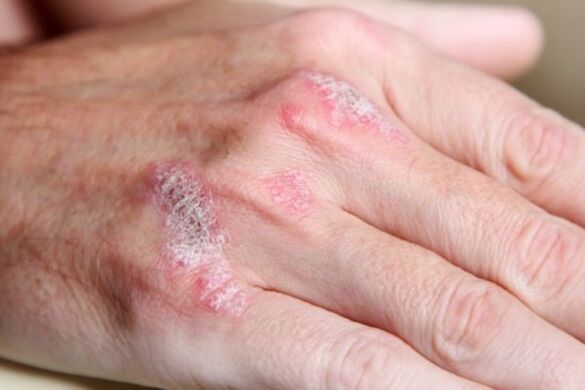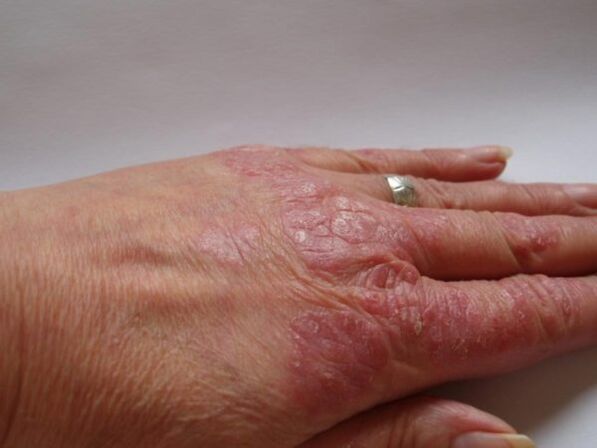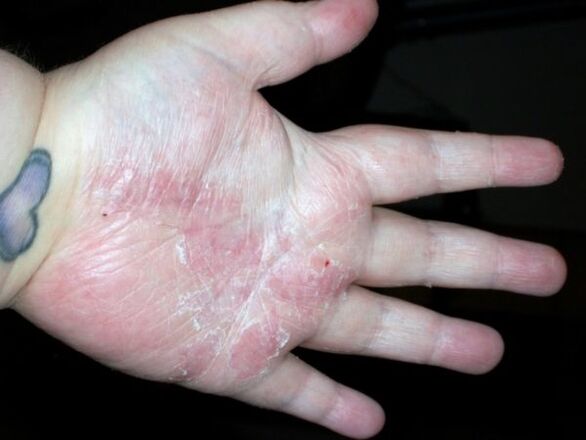Psoriasis is a chronic skin condition that cannot be completely cured. The disease requires symptomatic therapy to reduce the severity of the manifestations and improve well-being. Psoriasis of the hands is a common localization of the pathology. It starts with the appearance of small plaques and can progress without proper treatment.

Causes and mechanism of development
Psoriasis plaques on the hands, especially on the fingers, significantly affect quality of life. Even though the disease is not contagious, the strange skin flaws are alarming. Psoriasis is not the most pleasant disease, and not only because of its appearance, but also because of the risk of complications.
The exact etiology of the appearance of this dermatological disease has not been elucidated. Experts identify risk factors that may influence the development of the pathology. It is known that psoriasis does not spread through contact and cannot become infected upon contact with the patient.
It is also important that it cannot be completely cured, so one is forced to take supportive drugs throughout one’s life and carefully monitor the condition of the skin at different times of the year. Common exacerbations occur in spring and winter. Scientists consider the following factors in the development of the disease:
- genetic predisposition;
- immune deficiency, decreased protective function of the body;
- common skin lesions of viral, fungal, bacterial origin;
- sharp change in climatic conditions;
- chronic skin diseases, including congenital disorders;
- long-term use of certain medications, especially antispasmodics, antidepressants, and steroid hormones;
- psycho-emotional overload;
- metabolic disorders in the body.
Psoriatic plaques on the hands begin to appear in the area of the small joints, between the fingers, near the phalanges. Abnormal elements are more visible on the surface of the palms. Psoriasis with this localization is the most difficult to treat because the hands are often in contact with household chemicals and other irritants.

Risk group
The risk group for developing the disease includes men and women who often face other dermatological diseases. The likelihood of the disease increases if psoriasis has already occurred in the family.
Pathology can occur in people with weakened immunity, those who live in unsatisfactory living conditions. The risk group also includes those who are forced to come into contact with aggressive chemicals due to their activities.
Clinical manifestations
In the initial stage of the disease, the first signs are a single abnormal elements in the hands area. Plaques can appear on the hands, fingers, back of the palm. If nails are involved in the pathological process, there is a risk of loss of sensitivity and the appearance of tissue edema.
Increased dehydration of the skin causes cracks in the palms. There are signs of thickening of the epidermis, which is similar to calluses.

The main manifestations of psoriasis on the hands will be:
- increased dryness, severe redness;
- thickening of the epidermis, increase in finger volume due to edema;
- Cracking when the plaque cracks
- sometimes the merging of several elements damages healthy skin.
In winter and autumn, when cold days prevail, the disease manifests itself as intense exfoliation of the skin. Without treatment, it is possible to scratch your hands with an infection, then the symptoms are supplemented by signs of inflammation.
Forms of pathology

There are several forms of hand psoriasis:
- On the fingers. This manifests itself in peeling, the formation of plaques that often become inflamed. The aggravation occurs in winter. It often leads to complications.
- On the brushes. Occurs in 25% of patients, the signs are similar to psoriasis on the fingers, while the skin in the affected area becomes rough, reddening areas appear. The patient complains of constant discomfort, active peeling, itching.
- Palmar sole. It occurs in people who do hard physical work. The soles of the feet and palms are affected. Rough-skinned areas resemble solid calluses and very often cracks appear.
- Arthropathic. Psoriasis occurs in the background of joint damage. The elements of the rash are found in the phalanges. In addition to external manifestations, the patient is concerned about joint pain while moving and then at rest.
- Pustular. The palms and soles are affected. Stress and hormonal pathologies become risk factors. The rash has clear boundaries and pustules appear. The disease is often recurrent and difficult to treat.

Each form of the disease progresses in three successive stages - initial, progressive, and persistent. After one cycle (going through 3 stages), disease regression begins. At this stage, the clinical symptoms almost completely disappear. The goal of treatment is to prolong the regressive phase as much as possible, otherwise the disease cycle will be repeated over and over again.
Differential diagnosis
Psoriasis of the hands is distinguished by pathologies such as lichen planus, Reiter's disease, syphilis, seborrheic and atopic dermatitis.
The hallmark of psoriasis during the examination will be a triple psoriasis, in the presence of which the doctor can diagnose it. This includes stearinfol, punctate bleeding, and terminal film phenomena.
Treatment methods
Although psoriasis cannot be completely eradicated, it should be treated to avoid complications and improve quality of life.
The main measures for the treatment of psoriasis on the hands:
- use of lotions to hydrate and soften the skin;
- taking antihistamines to relieve itching;
- taking medications to increase immunity;
- further use of homeopathic remedies.
In the case of psoriatic lesions, physiotherapy and photochemotherapy may be prescribed. If psoriasis is accompanied by joint disease, painkillers from the group of nonsteroidal anti-inflammatory drugs are used.
Depending on the stage of the disease, your dermatologist will prescribe local anti-inflammatory drugs. It can be salicylic acid, ichthyol, sulfur tar ointment. Hormonal ointments can be used to quickly relieve the symptoms of severe itching and should not be used without your doctor's permission.
You can use baby creams for sensitive skin that contain herbal ingredients to soften and hydrate.
Preventive measures
General preventive measures to prevent psoriasis from getting worse:
- use of rubber gloves when cleaning the house if you need to come into contact with detergents;
- rejection of bad habits, good sleep and a balanced diet;
- daily hand care using natural cosmetics or medicines;
- regular sunbathing, frequent ventilation at home, walking in the fresh air, avoiding stress;
- treatment of the skin with a disinfectant in case of accidental injury (while long-term dressing of the wound is not recommended);
- adherence to the Pegano diet, which includes restricting meat dishes, sweets, and adding more cereals, vegetables, and herbs to the diet.
Prognosis of the disease
An unpleasant psoriasis rash on the hands causes a lot of suffering. However, experience only exacerbates the situation. Psoriasis can progress for a long time, but you must follow the therapeutic and preventive measures prescribed by your doctor.
It is impossible to get rid of psoriasis completely, but proper skin care, adherence to a diet and the use of special creams will hide the symptoms of the disease as much as possible. Regardless of the manifestations of the disease, it is recommended to consult a dermatologist every few months to monitor the dynamics of the disease and to adjust the treatment regimen if the condition requires it.























